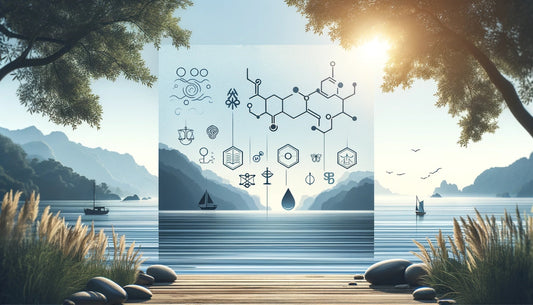Omega 3: why miss out on the key to a good life?
Omega 3 is a group of three polyunsaturated fats that are essential to good health, mental function and well-being. However, our bodies just don’t make them. We obtain them by eating foods rich in omega 3s or by taking supplements.
100% of people in our study were shown to be deficient in Omega 3. It is measured in terms of its ratio to omega 6. So the ideal ratio of omega 6 to omega 3 is 3:1. For anti-ageing it is even lower at 1:1.
Our analysis of our initial group of tests have returned an average of 11.1 to 1 with a low of 6.9 and a high of 17.4!
Omega 3: the key to a good life.
A deficiency can cause rough, scaly skin and a red, swollen itchy rash. If we are not careful in our food choices, a diet low in omega 3s can aggravate existing inflammatory conditions too.
The three types we need are ALA (alpha-linolenic acid) EPA (eicosapentaenoic acid) and DHA (docosahexaenoic acid), so given the tricky task of pronouncing their full chemical names, we’ll continue to call them the Omega 3’s and abbreviate to ALA, EPA and DHA!
The omega 3s go by the name of polyunsaturated fats or PUFAs. That’s not a bad way to visualise them either. Like a jacket, they form key parts of the cell membrane and its internal structure. These essential fatty acids are an important energy source and have functions in your heart, blood vessels, lungs, immune and hormone system.
The Power of 3
A lot of recent research into allergies, ageing and well-being, focus on eliminating stress and sources of inflammation from our bodies. This is where our bio-chemistry requires these essential building blocks for help. The three tasks they do are:
- Reduce and prevent inflammation in the body
- Promote balanced responses from our immune system
- Be an energy source for your heart, blood vessels, lungs, immune and endocrine system (hormone producing glands).
This means that omega 3s can, for example, help to keep our hearts healthy and lower the risk of heart attacks. They also support proper glucose and insulin metabolism. Low levels of DHA have been associated with memory loss, poor night vision and other neurological conditions. Whilst 60% of our brains are “Grey matter”, DHA is the type that grey matter needs. So, we need enough DHA in our diet to support pre-and postnatal brain development, help reduce age-related brain function decline and assist with our eye health.
Are you an "Omegan"?
To be sure to avoid deficiency, you need to be an “Omegan” and eat foods rich in these essential building blocks of well-being.
ALA is found in plant oils, such as flaxseed, soybean and canola. EPA and DHA are abundant in fish and fish oil, especially fatty fish such as sardines, herring, mackerel and wild-caught salmon.
Vegans and vegetarians can get plenty of ALA but this is not a type our body can use however DHA and EPA is found naturally in marine algae.
ALA is found in dark green vegetables, walnuts, flaxseed, chia seeds, hempseed and soybeans are great sources too. However, if you’re only getting your omega 3 from plant sources, which means only ALA, you may struggle to get enough DHA and EPA. Although your body will convert excess ALA into the two other essential PUFAs, EPA and DHA it is not vey efficient at doing so and may only convert about 5%.
Dietary supplements include fish oil, krill oil, cod liver oil and algae oil. Supplemental DHA from algae is suitable and approved for vegetarians, vegans, and others preferring a non-fish source. It’s always best to meet your dietary requirements through food. If you aren’t able to meet your requirements through you diet, a supplement should be considered. Always consult a healthcare professional before taking any supplements.
How common is low Omega 3?
We now have too much omega 6 in our diets and this tends to cause more inflammation. The ideal ratio of omega 6:3 is 3:1. For anti-ageing it is even lower at 1:1.
Our analysis of our initial group of tests have returned an average of 11.1 to 1 with a low of 6.9 and a high of 17.4!
Part of the reason for this is that the Western diet now has a ratio between 10:1 and 50:1.
Foods that previously would have been high like eggs (grass fed chickens 3-400mg per egg) no longer get fed the food that they need to make DHA and EPA even organic chickens get fed corn and soy and so now produce eggs with as little 5mg.
So look out for omega 3 enriched eggs that are fed on a special food stuff that contains seeds like flax that have the precursors required.
Skin
Omega 3 can improve the following conditions:
a) Eczema: they help to improve cell walls and reduce inflammation
b) Keratosis pilaris: the rough skin on the upper arms is linked to low omega 3. It can also be linked to gluten sensitivity.
c) Rosacea: reduction of the red inflammation seen with rosacea.
How can I increase omega 3 in my diet?
Oily fish have good levels of the best types (DHA and EPA). Although vegetarian sources such as flaxseed have omega 3 this is in the “precursor” form, ALA, which our bodies are not great at using*.
Fish: mackerel, salmon and herring.
Vegetarian sources*: flaxseed, walnuts, soybeans.
* This is in the simplified ALA form and does not always convert to the DHA and EPA that the body requires.
Fish actually get their these essential building blocks not by making them by consuming omegas formed by plankton on algae. For a super purified omega 3 we use a company that has filtered tanks that grow algae. This is suitable for vegans and is much better and more sustainable than trawling the Atlantic. It also avoids the risk of build-up of ocean-borne toxins.
References:
A Comprehensive Review of Chemistry, Sources and Bioavailability of Omega-3 Fatty Acids
Effects of Omega-3 Fatty Acids on Immune Cells
Omega-3 fatty acids EPA and DHA: health benefits throughout life
Omega-3 fatty acids and depression: scientific evidence and biological mechanisms






